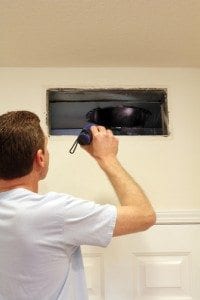Blog
5 HVAC Ductwork Design Principles for Efficiency and Effectiveness

Quality air duct design and installation play an essential role in your home’s energy efficiency and indoor air quality. An efficiently designed duct system can help your HVAC system deliver the right amount of conditioned air without wasting energy or creating excessive wear and tear on HVAC components.
An inefficient duct system design will force your air handler to work harder, may cause damage to your ducts, create uneven air flows, and lose energy. Efficient ductwork, on the other hand, creates smooth transitions for the conditioned air to travel through your house, delivers the conditioned air equally, and doesn’t create pressure vacuums.
There’s much more to ductwork design than simply creating a tree system, screwing all the ductwork pieces together, and hoping it works. Ductwork should be planned out by professionals who use design systems and math to produce an efficient HVAC central air duct system.
Consider the following HVAC design principles to make your air ducts efficient and long-lasting.
1. Fluidity
Most people think of air as a slow-moving gas that fills any space. While this isn’t necessarily untrue, it’s better to think of your ductwork system as a channel that is guiding a stream—air needs to be able to flow smoothly.
Hard stops and 90-degree angles create considerable inefficiencies in airflow and can eventually wear your duct system down, creating gaps in joints. Friction slows air down and creates heat. This means your air handler has to work harder to push slower air, and some of your cooled AC air gains heat.
The smoother and rounder the transition, the more efficient the airflow.
2. Materials & Shape
A well-designed ductwork system is made out of galvanized steel or fiberglass. Other materials don’t last, create too much friction, or are not economical. Don’t use shortcuts like closing up wall voids or creating ceiling joist channels. These will rob your system of energy and efficiency.
There are three standard shapes of air ducts—square, oval, and round. The most efficient ductwork shape is round. A round air duct has the least surface area for air to come into contact with, which means less friction and better airflow. Square and oval are used when ductwork has to fit into a specific space.
3. Air Pressure Balance
Have you ever been in a house where doors would suddenly slam shut? This is caused by a negative air pressure, often due to an open outside door or window. This can happen without outside doors or windows, however.
Efficiently designed air ducts account for air pressure. The volume of air entering and leaving a room must be balanced to maintain neutral air pressure. That’s why most room doors will have an inch of space between the door and the floor. This allows air to escape and move without creating negative air pressure.
Another balance to account for is distance from the air handler. The closer to the air handler the vent is, the more air pressure and flow it will receive, while vents further away from the handler will receive less airflow. This can create negative pressures as well.
Expert HVAC technicians avoid this by using manual dampers. Manual dampers will adjust how much airflow is being pushed into closer vents so that all vents have an equal air pressure. The strength of the dampers will have to be calculated to determine how much dampening is required.
Finally, the air return must always have a clear, unobstructed path. Don’t cover it up with a couch, curtains, or entertainment center. Having a clear air pathway will allow your system to avoid negative vacuum air pressure situations and put less strain on your HVAC equipment.
4. Unconditioned Spaces
An efficiently designed residential ductwork system keeps all of the ductwork within the conditioned zones of your home.
Ductwork in spaces that are not conditioned, like crawlspaces, basements, or attics, should be insulated to keep the conditioned air from losing or gaining heat. Insulation keeps cold air cold and hot air hot.
For the best duct efficiency, wrap all exposed ductwork with insulation.
5. Air Duct Sealing & Leak Testing
Testing air ducts for leaks and sealing any cracks is essential to having an efficient air duct system. Dust segments must be properly sealed with metal foil tape, mastic adhesive, or a combination of the two. Never use regular “duct” tape on ductwork, as it doesn’t last long.
HVAC technicians should perform a leak test before making the final connections to the rest of the HVAC system to ensure all joints are correctly sealed.
Apollo Home provides professional HVAC duct system design and installation services. Our licensed HVAC technicians have received all the training, theory, design systems, tools, and hands-on experience necessary to provide expertly designed and installed HVAC central air ductwork systems.
Contact us for quotes on a ductwork system installation, replacement, or repair service in Cincinnati.



